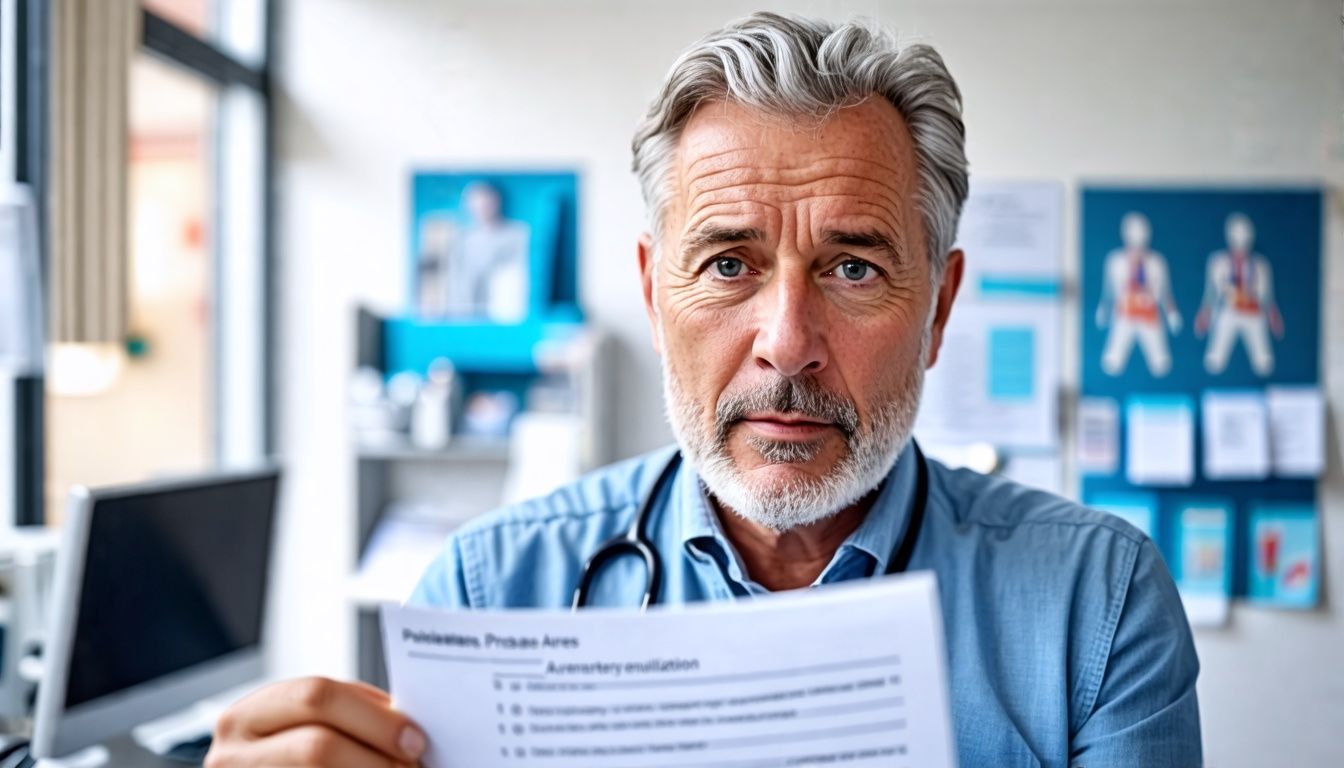Greetings! If you’re a man over 50, you may be familiar with the frustrating symptoms of an enlarged prostate, also known as benign prostatic hyperplasia (BPH). This non-cancerous condition affects millions of men and can disrupt daily life. But don’t worry, we’re here to help! In this article, we’ll explore various treatment options for an enlarged prostate, from natural remedies to conventional treatments, so you can find relief and regain control of your life.
Key Takeaways:
- There are numerous things you can do to treat an enlarged prostate.
- Lifestyle changes, such as diet modifications and exercise, can help manage symptoms.
- Natural remedies and alternative therapies may provide relief for some individuals.
- Conventional treatments, such as medication and surgical procedures, are available for more severe cases.
- Consulting with a healthcare professional is crucial to determine the best approach for your specific situation.
Get Sufficient Exercise
Regular exercise is beneficial for both overall fitness and prostate health. Engaging in physical activity, regardless of the type, has been shown to reduce the risk of developing an enlarged prostate, or benign prostatic hyperplasia (BPH). In addition to general exercise, specific exercises targeted at the pelvic muscles can be particularly beneficial.
Exercise and BPH
Research has indicated a clear link between physical activity and a decreased risk of BPH. Studies have found that men who engage in regular exercise are less likely to develop an enlarged prostate compared to those who lead a sedentary lifestyle. Physical activity helps maintain a healthy weight, improve circulation, and regulate hormone levels, all of which contribute to prostate health.
Kegel Exercises for Prostate Health
Kegel exercises, which involve contracting and relaxing the pelvic floor muscles, offer specific benefits for prostate health. These exercises strengthen the muscles that control urine flow, reducing instances of urine dribbling and improving bladder control.
Performing Kegel exercises is simple and can be done anytime, anywhere. To get started:
- Identify the muscles: Start by stopping urination mid-stream. The muscles you engage to do this are the same ones you’ll be targeting with Kegel exercises.
- Contract the muscles: Squeeze the pelvic floor muscles and hold the contraction for a few seconds.
- Release and repeat: Relax the muscles and repeat the process, aiming for a series of 10 contractions, three times per day.
In addition to Kegel exercises, incorporating regular aerobic exercise, such as walking, swimming, or cycling, can further promote prostate health. However, it’s important to note that any physical activity, whether it be gardening, dancing, or playing a sport, can contribute to overall fitness and prostate well-being.
When engaging in activities that involve sitting, such as cycling, it’s recommended to use a wide seat or padded bicycle shorts to minimize pressure on the perineum and groin area. This can help prevent discomfort and reduce the risk of exacerbating prostate-related symptoms.
Slow Down
When experiencing slow urination due to an enlarged prostate, it is crucial to take your time and allow your muscles to relax fully to ensure complete bladder emptying. Rushing through the process can result in urine remaining in the bladder, which can lead to complications such as urinary tract infections and bladder stones. By slowing down and giving yourself enough time, you can help prevent these issues and maintain optimal bladder health.
One effective technique is to take deep breaths and focus on relaxing your pelvic muscles while urinating. By doing so, you can promote a more thorough and efficient emptying of the bladder. Take your time, be patient, and let the flow of urine come out naturally without straining or forcing it.
Remember: slow and steady wins the race when it comes to emptying your bladder!
Complications of Urine Remaining in the Bladder
Allowing urine to remain in the bladder can have several complications and consequences, especially for individuals with an enlarged prostate. These complications can include:
- Increased risk of urinary tract infections (UTIs): When urine lingers in the bladder, it creates an ideal environment for bacteria to multiply and cause infections. UTIs can lead to pain, discomfort, and additional complications if left untreated.
- Bladder stones: Prolonged urine retention can contribute to the formation of bladder stones, which are hard mineral deposits that can cause pain, blockages, and further difficulties with urination.
- Urinary incontinence: In some cases, chronic urine retention can weaken the bladder muscles, leading to urinary incontinence or the inability to control urine flow.
- Incomplete emptying: Failing to fully empty the bladder can result in a constant feeling of needing to urinate, even after using the restroom. This can be bothersome and disruptive to daily activities.
To avoid these complications, make it a priority to slow down and ensure complete bladder emptying when urinating. Taking this simple step can significantly reduce the risks associated with urine remaining in the bladder and improve your overall urinary health and quality of life.
The Importance of Patience and Persistence
Changing your urination habits may take some time and practice, especially if you’ve been rushing through the process for years. Be patient with yourself and give your body the time it needs to adjust to the new approach.
Remember, treating an enlarged prostate is a journey, and every small step counts. By slowing down and prioritizing full bladder emptying, you can minimize the risk of complications and take control of your urinary health.

| Complications of Urine Remaining in the Bladder | Description |
|---|---|
| Increased risk of urinary tract infections (UTIs) | Urine sitting in the bladder provides a breeding ground for bacteria, increasing the likelihood of developing painful UTIs. |
| Bladder stones | Stagnant urine can contribute to the formation of mineral deposits in the bladder, causing discomfort, blockages, and urinary issues. |
| Urinary incontinence | Prolonged urine retention can weaken the bladder muscles, leading to involuntary urinary leakage. |
| Incomplete emptying | Not fully emptying the bladder can result in a persistent sensation of needing to urinate, even after using the restroom. |
Reduce Caffeine and Alcohol Consumption
If you’re dealing with an enlarged prostate, reducing your caffeine and alcohol consumption can have significant benefits. These substances can irritate the prostate and bladder, leading to increased urgency to urinate. Furthermore, they can weaken bladder muscles and stimulate the kidneys, exacerbating the symptoms of an enlarged prostate.
By cutting back on your coffee and alcohol intake, especially in the evening, you can alleviate some of the uncomfortable symptoms associated with an enlarged prostate. This simple lifestyle change can make a noticeable difference in your overall prostate health.
Why Caffeine and Alcohol Affect Your Prostate
Both caffeine and alcohol have diuretic properties, meaning they increase urine production. When you consume these substances in excess, it puts added strain on your bladder, making it more difficult to manage the frequent urination associated with an enlarged prostate. Moreover, caffeine and alcohol can irritate the prostate gland and bladder, leading to inflammation and discomfort.
Reducing your caffeine intake can be challenging, especially if you rely on coffee to kickstart your day. However, there are alternatives such as herbal teas or decaffeinated coffee that can help you gradually decrease your caffeine consumption without completely cutting it out. Similarly, moderating your alcohol intake by opting for non-alcoholic beverages or limiting your alcoholic drinks can significantly improve your prostate health.
Remember, it’s always important to consult with your healthcare professional to develop a personalized plan that suits your specific needs.
“Limiting caffeine and alcohol consumption can help minimize irritation to the prostate and bladder, reducing urinary urgency and discomfort.” – Dr. Emily Johnson
To further illustrate the impact of caffeine and alcohol on prostate health, let’s take a closer look at a comparison table:
| Caffeine | Alcohol | |
|---|---|---|
| Effect on Prostate | Can irritate the prostate and bladder, leading to inflammation | Can weaken bladder muscles and stimulate the kidneys |
| Urinary Symptoms | Increases frequency and urgency to urinate | Can exacerbate urinary symptoms associated with an enlarged prostate |
| Overall Prostate Health | Reducing caffeine consumption can alleviate symptoms and improve prostate health | Limiting alcohol intake can help manage symptoms and promote better prostate health |

Switch to Comparable Medications
When it comes to managing the symptoms of an enlarged prostate, certain medications can actually worsen the condition. It’s crucial to inform your doctor about all the medications you are taking to ensure they are not exacerbating your prostate symptoms. By discussing your medication regimen with your healthcare provider, you can explore alternative options or adjust your medication schedule to alleviate urinary issues.
Some over-the-counter and prescription medications have been known to worsen symptoms of an enlarged prostate, such as:
| Medications that Worsen Prostate Symptoms | Alternative Medications for Enlarged Prostate |
|---|---|
| Decongestants (e.g., pseudoephedrine) | Nasal saline sprays |
| Antihistamines (e.g., diphenhydramine) | Non-drowsy antihistamines |
| Antidepressants (e.g., amitriptyline) | Alternative antidepressants without urinary side effects |
| Diuretics (e.g., hydrochlorothiazide) | Alternative medications for managing blood pressure |
| Antipsychotics (e.g., haloperidol) | Alternative antipsychotics without urinary side effects |
Switching to comparable medications that do not worsen prostate symptoms can significantly improve your quality of life. It is essential to work with your doctor to find suitable alternatives that effectively manage your medical conditions while minimizing urinary issues.
Prescription Medications
Prescription medications are often recommended as a higher-level treatment for an enlarged prostate. Two commonly prescribed types of medications for managing symptoms of an enlarged prostate are alpha blockers and 5-alpha reductase inhibitors.
Alpha Blockers
Alpha blockers, such as Flomax, Rapaflo, and Cardura, are medications that work by relaxing the muscles around the prostate and bladder neck. This relaxation helps to improve urine flow and decrease symptoms associated with an enlarged prostate, such as frequent urination, weak urine stream, and urinary urgency.
5-alpha Reductase Inhibitors
Another type of medication used to treat an enlarged prostate is 5-alpha reductase inhibitors. Examples of 5-alpha reductase inhibitors include Proscar and Avodart. These medications work by blocking the production of dihydrotestosterone, a hormone that contributes to prostate gland enlargement. By reducing the levels of dihydrotestosterone, 5-alpha reductase inhibitors can help shrink the size of the prostate and alleviate symptoms.
Both alpha blockers and 5-alpha reductase inhibitors have been proven effective in reducing symptoms and improving quality of life for men with an enlarged prostate. Your healthcare provider will determine the most suitable medication based on your specific condition and medical history.
| Medication | How It Works | Common Side Effects |
|---|---|---|
| Alpha Blockers | Relax the muscles around the prostate and bladder neck to improve urine flow. | Dizziness, fatigue, nasal congestion, abnormal ejaculation. |
| 5-alpha Reductase Inhibitors | Block the production of dihydrotestosterone to shrink the size of the prostate. | Decreased libido, erectile dysfunction, breast enlargement or tenderness. |
Surgery and Minimally Invasive Procedures
In moderate to severe cases of BPH, surgical treatments or minimally invasive procedures may be recommended to alleviate symptoms and improve quality of life. These procedures aim to reduce the size of the prostate or remove excess tissue obstructing the urinary flow. One common surgical treatment for enlarged prostate is the Transurethral Resection of the Prostate (TURP) procedure.
TURP involves the removal of prostate tissue through the urethra using a special instrument. It is performed under anesthesia and may require a short hospital stay. TURP has been proven effective in relieving urinary symptoms associated with BPH and improving urine flow. However, like any surgical procedure, TURP carries some risks and potential complications, such as bleeding or erectile dysfunction.
In addition to TURP, there are other minimally invasive techniques available for the treatment of BPH. These procedures offer the advantage of less tissue trauma, shorter recovery times, and reduced risk of complications compared to traditional surgical methods. Some of these techniques include:
- Transurethral Incision of the Prostate (TUIP): Involves making small incisions in the prostate to widen the urethra and facilitate urine flow.
- Laser Therapy: Uses laser energy to remove or vaporize excess prostate tissue, reducing the obstruction.
- Water Vapor Thermal Therapy: Involves the targeted application of heated water vapor to the prostate, causing the excess tissue to shrink and improve urine flow.
Comparison of Surgical and Minimally Invasive Procedures for BPH
To gain a better understanding of the different treatment options, let’s compare the common surgical procedure, TURP, with the minimally invasive techniques:
| Treatment Method | Advantages | Disadvantages |
|---|---|---|
| TURP |
|
|
| Minimally Invasive Techniques |
|
|
It’s important to consult with a urologist to determine the most suitable treatment option based on individual health, symptom severity, and personal preferences. They can provide a thorough evaluation and guide you towards the best course of action to manage BPH effectively.
Conclusion
An enlarged prostate can cause frustrating symptoms and disruptions to daily life. However, there are various treatment options available, ranging from lifestyle changes and medication to surgical procedures. It is important to consult with a healthcare professional to determine the best approach based on individual health and severity of symptoms.
With proper management and treatment, it is possible to alleviate the symptoms of an enlarged prostate and improve overall quality of life.
Remember, each person’s situation is unique, and what works for one individual may not work for another. By working closely with your healthcare provider, you can create a personalized treatment plan that addresses your specific needs and goals.
Don’t let an enlarged prostate hold you back. Take control of your health and take the steps necessary to manage your symptoms effectively. With the right care, you can continue to live a fulfilling and active life.
FAQ
What can I do to treat an enlarged prostate?
There are various treatment options for an enlarged prostate, including lifestyle changes, medication, and surgical procedures. It is important to consult with a healthcare professional to determine the best approach for your individual health and severity of symptoms.
Are there any natural remedies for an enlarged prostate?
While there is limited scientific evidence to support the effectiveness of natural remedies, some men find relief from symptoms by incorporating herbal remedies, such as saw palmetto and beta-sitosterol, into their daily routine. It is essential to discuss these options with your healthcare provider before starting any new treatments.
What lifestyle changes can help manage an enlarged prostate?
Making certain lifestyle modifications can help alleviate symptoms of an enlarged prostate. Examples include avoiding caffeine and alcohol, practicing regular exercise, and emptying the bladder completely when urinating. It is also recommended to maintain a healthy diet and manage stress levels.
What conventional treatments are available for an enlarged prostate?
Conventional treatments for an enlarged prostate include prescription medications such as alpha blockers and 5-alpha reductase inhibitors. These medications can help improve urine flow and reduce the size of the prostate. Surgical procedures, such as transurethral resection of the prostate (TURP) and laser therapy, may be necessary for more severe cases.
How can exercise benefit prostate health?
Regular exercise, including any type of physical activity, has been shown to improve overall fitness and benefit prostate health. Studies have indicated a connection between increased physical activity and a reduced risk of developing an enlarged prostate.
What are Kegel exercises, and how can they help with an enlarged prostate?
Kegel exercises involve squeezing and releasing the muscles that affect urine flow to strengthen the pelvic muscles. These exercises can help reduce urine dribbling and improve bladder control, thereby alleviating symptoms of an enlarged prostate. It is recommended to consult with a healthcare professional or a physical therapist to learn how to perform Kegel exercises correctly.
Why is it important to slow down when urinating?
Slowing down when urinating allows your muscles enough time to relax, ensuring that your bladder is fully emptied. Failure to empty the bladder completely due to an enlarged prostate can lead to complications such as urinary tract infections and bladder stones. Taking your time and allowing your body to fully empty the bladder can help prevent these issues.
How does caffeine and alcohol consumption affect an enlarged prostate?
Consuming excessive amounts of caffeine and alcohol can irritate the prostate and bladder, leading to increased urgency to urinate. These substances can also weaken bladder muscles and stimulate the kidneys. Cutting back on coffee and alcohol intake, especially in the evening, can help alleviate symptoms of an enlarged prostate.
Are there any medications that can worsen symptoms of an enlarged prostate?
Yes, some over-the-counter and prescription medications can worsen symptoms of an enlarged prostate. It is important to inform your doctor about all the medications you are taking to determine if any can be switched to alternatives or if the medication schedule can be adjusted to reduce urinary issues.
What are some prescription medications available for managing an enlarged prostate?
Prescription medications commonly prescribed for an enlarged prostate include alpha blockers, which relax the muscles around the prostate to improve urine flow, and 5-alpha reductase inhibitors, which block the production of dihydrotestosterone and shrink the size of the prostate. These medications can help reduce symptoms and manage the condition.
Are there surgical options available for treating an enlarged prostate?
For moderate to severe cases of an enlarged prostate, surgery or minimally invasive procedures may be necessary to relieve symptoms. Common surgical treatments include transurethral resection of the prostate (TURP) and transurethral incision of the prostate (TUIP). These procedures involve removing or incising prostate tissue to improve urine flow. Other techniques, such as laser therapy and water vapor thermal therapy, may also be options. It is important to discuss the risks, benefits, and potential side effects of these procedures with your healthcare provider.
Can Peanut Butter Help with Enlarged Prostate?
Peanut butter for prostate health is a popular topic of discussion. While there is no direct evidence linking peanut butter to enlarged prostate relief, it does contain nutrients like Vitamin E, which may support prostate health. However, moderation is key due to its high calorie and fat content.



